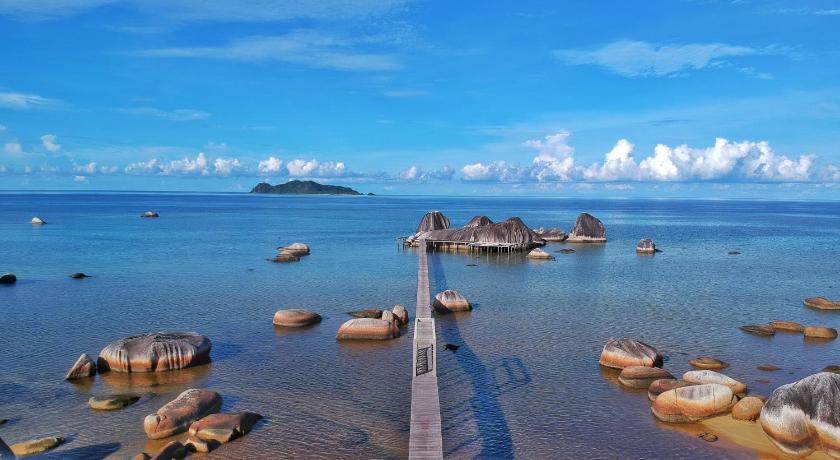The tropical islands of the Anambas archipelago are located 270 km northeast of Singapore in the Natuna Sea and comprise of 255 islands, with only 25 inhabited by approximately 50,000 residents. Renowned among divers and sailors as a tropical wilderness for coral reef diving and cruising the islands are gaining recognition globally. The Indonesian government is prioritising infrastructure to support sustainable tourism growth, leveraging the islands’ pristine beauty and strategic proximity to Singapore to position the Anambas for premium eco-tourism.
Geography of the Anambas Islands
The Anambas combines Maldives-like turquoise waters and palm lined white beaches with dramatic karsts, cliffs and outcrops reminiscent of Vietnam’s Ha Long Bay. Secluded beaches, hidden coves, and untouched islands offer opportunities for both culturally immersive eco-tourism and premium resort development.
Environment
The archipelago is a place of extraordinary natural beauty. A tropical wilderness with 230 uninhabited islands, in a designated 1.2-million-hectare marine park, which is itself within the world’s renowned coral triangle initiative zone.
Rare and tropical flora and fauna can be discovered throughout the province. From 6 of the world’s 7 sea turtle species, including their nesting sites, through to sea eagles, resident butterfly and tropical bird populations and seasonal waterfalls inside the rich tropical forest canopies. It’s sea scapes are rich with biodiversity and ancient coral reefs. It is a place where time stands still, and the sights and sounds of nature are rarely interrupted by any signs of human habitation.
Culture and Population
Anambas culture blends Malay, Chinese, and Bugis influences. Traditional dishes include nasi dagang, otak-otak, and laksa Anambas. Festivals like Budaya Tuah Utare celebrate regional Malay heritage. The local population is ethnically diverse, with most of the population concentrated on the main islands of Matak, Siantan, and Jemaja.
Weather and Climate
The islands have a balmy tropical climate and experience year-round warmth (26–29°C), calm seas, and alternating dry (April–October) and rainy seasons (October–March). Ideal weather conditions support activities like snorkelling, kayaking, snorkelling and diving throughout most of the year.
Travel & Logistics
How to get there? Visitors typically travel via ferry from Singapore to Batam, followed by a short 1hr 15-minute flight to Letung Airport. Inter-island travel is on ferries, water taxis, private speedboats, and charter yachts. Bawah Reserve offers direct seaplane service from Batam. For those lucky few staying at the renowned Bawah reserve, you can catch seaplanes directly from Batam airport to the Bawah reserve lagoon.
Key Locations
The main towns Letung and Terempa are 70 km apart, connected by regular ferry service. The archipelago has two airports (Letung for public flights, Matak for private operations) and unique stilt-house villages over the bays and inlets spread across a few other main islands in the province.
Accommodation & Resorts
Accommodation in the Anambas islands ranges from budget homestays ($10/night) to ultra-luxury resorts like Bawah Reserve at up to $35,000/night! Mid-range options include Tenggiling Island cottages ($165/night) for those wanting a secluded and affordable island getaway.
Tourism & Attractions
Anambas attractions include waterfalls (Temburun, Air Binyi), coral reefs, diverse marine life (including whale shark migrations), and cultural sites. Activities span island-hopping, camping, jungle trekking, snorkelling, diving shipwrecks, and encountering rare tropical wildlife.
Geology
The islands are geologically stable and are positioned well away from major tectonic boundaries, minimising earthquake or tsunami risks, a significant advantage for investors seeking a region a unique and picturesque environment without the risks of major weather or climate risks.
Future Infrastructure
Infrastructure developments to accommodate increasing tourism include expanding Letung Airport’s runway for international flights, completion of a new terminal, and planned construction of a ferry terminal accommodating cruise ships from Singapore, Malaysia, and Hong Kong. Developers are also establishing direct seaplane access from Singapore’s Seletar airport which will bring island resorts with 1hr of Singapore and it’s 400 direct global destinations.
Conservation and Preservation
Government, NGO, and private efforts (e.g., marine parks, turtle conservation, Bawah Foundation activities) underline strong commitment to environmental sustainability and community-driven preservation initiatives in the region, and it’s designation as a 1.2 million hectare marine park should ensure the pristine environment remains so, for the generations to follow.
Development & Investment Opportunities
Development sites have been limited by legislation to maintain the environment, and with limited competition and the extraordinary yield demonstrated by the only 5 star development in the province, the Anambas present significant potential to investors. Developments like The Pavilions Anambas (luxury residences and guest villas) exemplify sustainable luxury tourism potential. Other planned developments include eco-focused resorts and wellness retreats.
Investing in the Anambas Islands
Land prices ($4.68–$115.20/m²) remain significantly lower than established regions like Bali and Lombok, offering an opportunity for premium developments in a superior environment for substantially less capital costs. Scarcity and limited development zones will likely drive appreciation, supported by government policies and growing international brand presence. Kepri Estates offers a range of carefully curated sites in the province that have been thoroughly researched to provide maximise uplift and yield for developers.
Future Outlook
With increasing global demand for sustainable tourism, the Anambas Islands provide a unique opportunity for both tourists and developers to shape the region’s future. Limited, thoughtful development alongside conservation efforts will ensure long-term ecological and economic sustainability, promising significant uplift potential, and superior ESG credentials.
For deeper insights, Kepri Estates has comprehensive guides on travelling the region and also offers extensive developer support services for those investing in this new and exciting destination.
In conclusion, the Anambas Islands offer unspoiled beauty, cultural authenticity, and significant growth opportunities, and is poised to become a benchmark in sustainable and profitable resort development for the premium eco-tourism industry and it’s guests.








/socialsamosa/media/media_files/2zHb3sGz3BcGQQrVtOoh.png)
